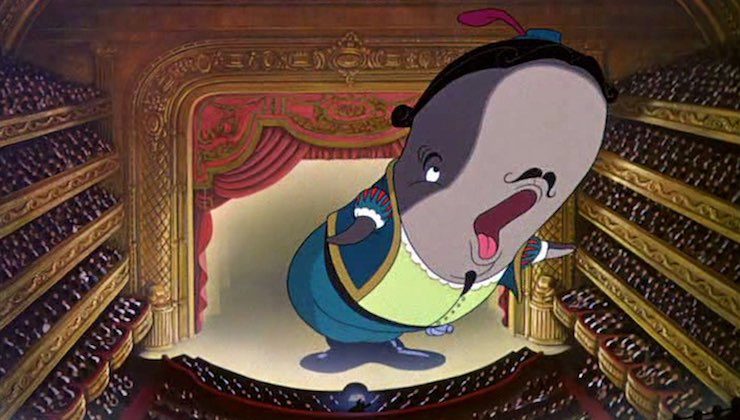Walt Disney had originally hoped to rerelease Fantasia, his blending of animation and classical music, every few years, adding and subtracting material each time. Abysmal box office receipts and the outbreak of World War II put an abrupt end to that plan. Disney still had stacks of unused concept art both for the original film and for some proposed new pieces, however, and the two package films released after Walt Disney’s goodwill tour to South America—Saludos Amigos and The Three Caballeros—if not quite box office hits, had done better than Fantasia—suggesting that Disney could find a market for another collection of cartoon shorts.
With the income from World War II training films and propaganda shorts about to come to an end, and still lacking the funds for a full length feature, Disney ordered the shorts put into production towards the end of World War II, to create a third anthology film, Make Mine Music. It wouldn’t be quite the same as Fantasia—the shorts would focus less on classical numbers and more on contemporary music, including some big names—Nelson Eddy, the Andrews Sisters, and Dinah Shore—that Disney hoped would be box office draws. At the least, it would allow the studio to release a film. At best, it could justify Fantasia.
Before I get to the film, however, a disclaimer and a rant: Make Mine Music is difficult to find in its original form. It’s the only one of the anthology films not currently available through streaming services, and the North American DVD release—as indignant Amazon.com customers will remind you, at length—is missing the opening cartoon, The Martins and the Coys, along with several other frames from later cartoons. Oddly, Disney had no problems playing the full versions of all of the shorts on the Disney Channel back in the day. Apparently, DVDs are where Disney now draws the line.
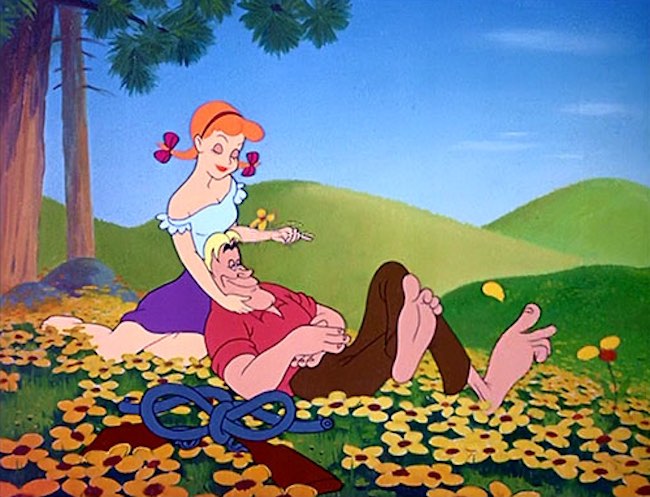
From the point of view of this post, though, the even bigger issue is that the 2011 DVD edition does not use the original 1946 aspect ratio, which means that part of the animation is missing. And, if you care about such things, the film and the sound have apparently not been digitally restored. (I say “apparently” since the copy I watched was from the Orange County Library, and may have gained some additional scratches along the way.) Which is to say, I’m kinda guessing about what the original film looked and sounded like here, and that this post might include a few more near-expletives and digressions about how fun it might have been to, you know, see the entire frame before trying to write a post about it.
First digression: Much thanks to the multiple people who offered helpful suggestions about adjusting the TV screen and DVD player to try to get the aspect ratio back, and then also helped me get everything back to the original settings so that I could watch the Olympics, which NBC was broadcasting in the filmed aspect ratio.
Anyway, back to the post. The result, Make Mine Music, is generally dismissed—when it’s mentioned at all—as a poor copy of Disney’s Fantasia. It’s not an unfair assessment, and not just because of the above DVD issues, since at least one section—The Blue Bayou piece that currently leads off the film—was originally intended to appear in Fantasia, if with different music. It’s both a lovely piece EVEN THOUGH YES I CAN TELL THAT THE TOP OF THE IMAGE IS MISSING FROM THE DVD, Disney, and a piece I highly recommend as a cure for insomnia.
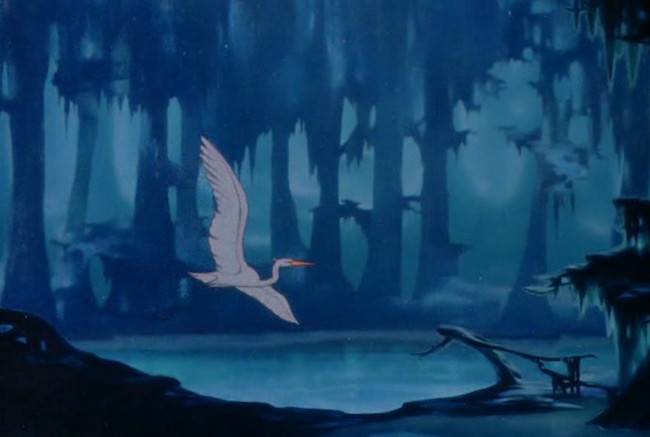
Second digression: Ordinarily, I wouldn’t direct you to a completely unauthorized YouTube version of one of the shorts here, but if you are interested in what Blue Bayou might have looked and sounded had Disney stuck with the original choice of music, Clair de Lune, well, you’re in luck—an enterprising YouTuber has created that version for you, and no, I’m not just pointing this out because of my irritation with the DVD.
(I’m totally pointing this out because of my irritation with the DVD.)
Anyway. Make Mine Music also generally lands in “poor copy” territory because, with a few exceptions, nothing here comes even close to the detailed animation work of the earlier movie, let alone the buoyant creativity. Instead of first choosing music, and then drawing images inspired by that music, the process here, with one exception, seems to have been the direct opposition—with cartoon and concept art drawn first, and music chosen to accompany it. One section, The Whale Who Wanted To Sing at the Met, features multiple pieces, and is more a short about opera and singing and miracles than about any one particular musical number. One section, Casey at the Bat, isn’t even a musical number, really, although people sing in it.
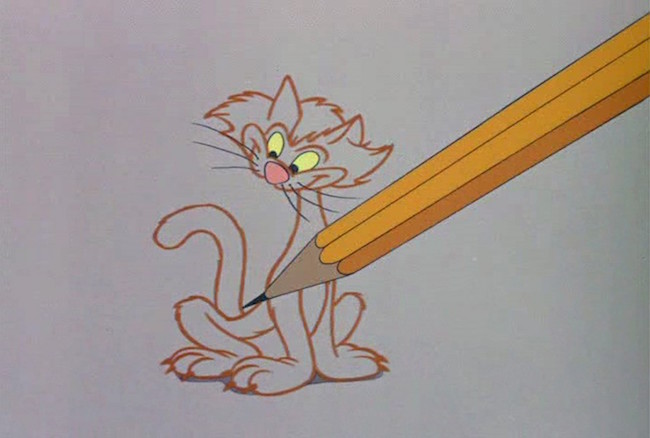
So it’s not Fantasia, although like the earlier movie, it does present itself as a series of animated musical numbers, in this case, linked not through images of an orchestra and a conductor, but brief headers giving each piece some sort of musical function—for instance, a “jazzy interlude” for All the Cats Join In (sadly, a piece that has very few actual cats) and a “musical recitation” for Casey at the Bat (this is a stretch, to put it mildly), or “a ballad in blue” for, no, not Blue Bayou but for Without You.
The shorts are, again to put it mildly, rather mixed. Blue Bayou, the “tone poem” which currently starts things off, certainly looks lovely, with its depiction of a white egret wading and flying through, well, a blue bayou, before finding another egret and flying off. Unfortunately, the music here has not aged well, and as noted, it works best as a cure for insomnia. The same can be said for some of the other shorts, especially those that do not tell a story, particularly Without You and Two Silhouettes.
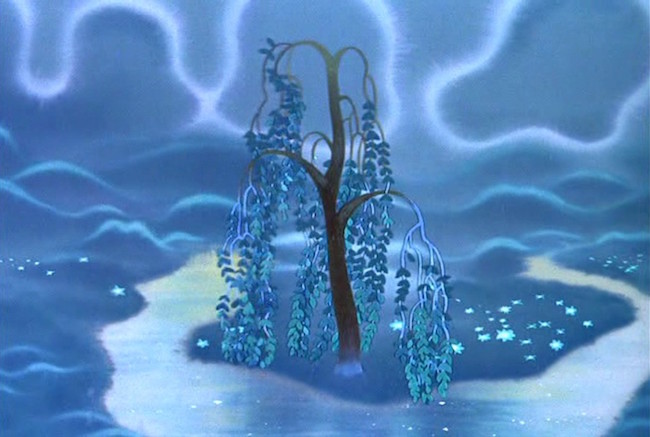
Without You, or, as Disney also calls it, A Ballad in Blue, is—I’m actually not sure what this is, or why Disney made it. The song itself seems to be crying out for an actual story with actual people staring longingly at each other, or, better yet, a nice ghost, since the singer keeps singing “without you,” so presumably, the “you” he’s singing about died of boredom, or of seeing way too much blue. (Or just took off, but I like my version better, plus, my version allows for a possibility of a ghost.) What actually happens is the song keeps going and going and going while the camera pans over some blue images because, ballad in blue, get it? No? Even when they start turning to more pink and red images? Still no?
It’s ok; I didn’t either, and the various sources I consulted for this post were either equally at a loss or still frothing at the mouth over the DVD issues. Maybe the animators just felt really really blue, and wanted to experiment with the color. Or maybe it’s meant to represent feeling blue—that is, depression—and since the song would certainly put anyone in that state, let’s go with that thought. Frustrating as it is, because I get the sense that this is a piece that might work with another song—any other song, or at least something more abstract or classical—but staring at blue images to someone crooning “without you” is…
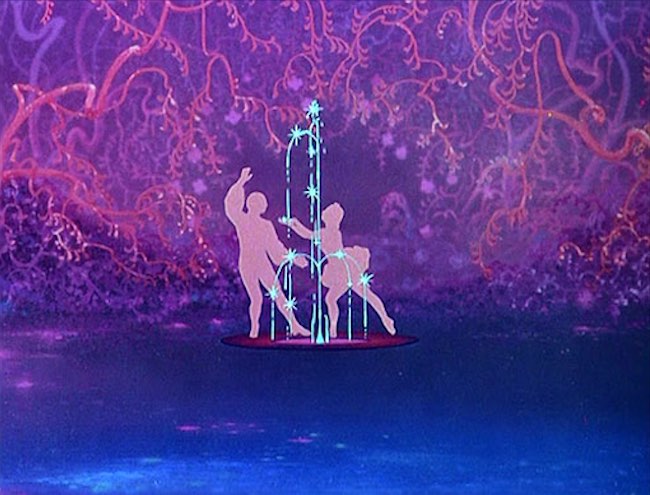
Yeah, let’s just move on. Two Silhouettes, the other storyless short, is a “ballet ballad,” and is pretty much exactly what it says on the tin: two animated silhouettes of ballet dancers, dancing to yet another syrupy song, this one by Dinah Shore. Again, pretty enough, but soporific. And unfortunately, it also includes silhouettes of those atrociously cute cupids from Fantasia—why did you let them escape, oh film and Greek gods? Why?
The rest of the shorts work somewhat better. After You’ve Gone, which transformed jazz musician Benny Goodman and his band into various anthropomorphic instruments dancing, dueling and chasing one another across the screen, does at least offer more energetic music, as well as a hint that the animators had not fully recovered from their surreal spring on The Three Caballeros. I am somewhat disturbed by the images of two separate pairs of legs—without people attached to the tops of them—running along a keyboard, especially since the legs started out as disembodied hands. On the other hand, this section also features a moment when two of the instruments face each other in a wrestling ring as their separate instruments answer each other in the soundtrack.
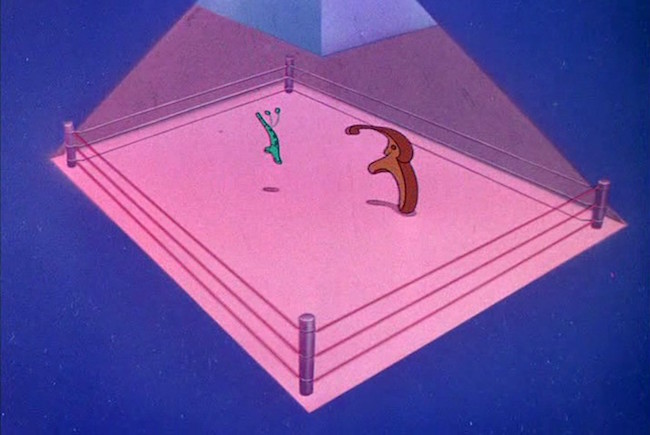
All the Cats Join In—another short featuring Benny Goodman and his band—uses the technique of letting us watch the animators draw the action—in some cases, barely keeping up with the action, letting one cartoon character fall to the floor because a chair wasn’t drawn in time. In one case, one of the characters glares at the animator, who uses an eraser to make her thinner—and thus immediately able to attract a boy.
That part aside, the cartoon has some adorable moments—like the one when the little sister is just about to head down the stairs until the animator kindly steps in and draws her a banister to slide down on. Above all, it’s a happy piece, filled with characters dancing and swinging and eating ice cream and, just in general, having fun. Its buoyant tone is in delightful—and needed—contrast to the rest of the film; it may be the most enjoyable short here.
I say may because this was the short that came in for some severe criticism for its shower scene, in which a teenage girl is first clearly naked (if in silhouette) in the shower, and later only covered by a towel, and not all that covered, and a later scene where, as the girls dance, their skirts pop up, exposing their (very modest) underwear. There’s nothing here to shock contemporary viewers, but for late 1940s viewers who has been forced to endure the sight of Disney drawing flower bras to protect the modesty of its young centaurettes, it was shocking indeed.
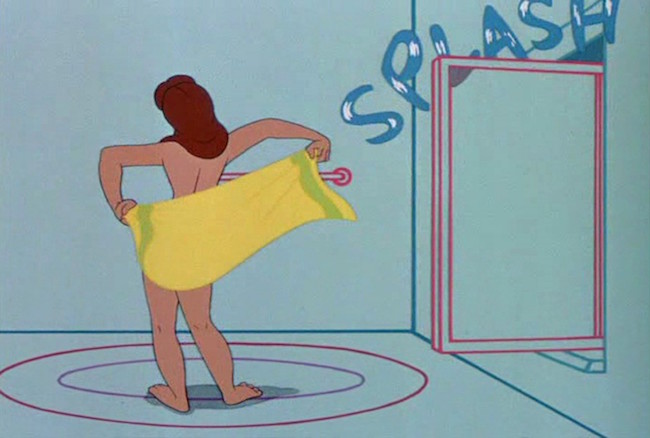
Less shocking—at least at the time—was anything in Casey at the Bat, an animated version of the famous baseball poem by Ernest Thayer. The short starts off with what was now becoming a time-honored Disney technique to save money: instead of immediately jumping into animation, the camera instead lingers over a few paintings—sometimes, not even panning across or moving in for a closeup to give the illusion of movement.
It also immediately jumps into sexism, with the cheerful lyrics:
The ladies don’t understand baseball a bit,
they don’t know a strike from a foul or a hit –
….as the women enter the stadium. Later, the cartoon shows us men in the stands watching the game, as women in big hats coo over Casey, giving us more cheerful lyrics:
Casey’s the guy with his eye on the ball,
but mostly the ladies,
Casey’s the guy who’s the idol of all –
But mostly the ladies.
….and a few frames later the ladies in the stands are passing out just because Casey has waved at them.
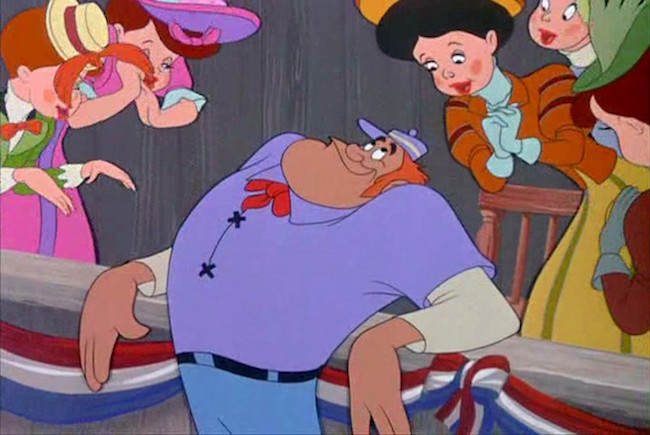
One “someone” in the original poem has been changed to a “cutie.” A few frames later, and Casey gets strike two because he is looking at a magazine filled with pictures of buxom women.
None of this is in the original poem, which describes the fans in the stands as “patrons,” “people,” “throats,” “eyes,” and “willing to kill,” without distinguishing their genders at all, and never suggests that Casey is particularly interested in or distracted by women. Also not in the original poem: several violent scenes where fans in the stands savagely beat up another hopeful—and decidedly smaller—fan, a pause to make fun of a character’s long moustache, and a bit where another character’s shoes catch on actual fire.
Along with the final scene—showing a sobbing Casey tossing balls up in the air, desperately trying to hit them as the rain pours down around him—it all displays an inherent cruelty nowhere in the original poem, all played for laughs. I like the bit where the guy’s moustache—mocked just a few frames earlier—reaches out to touch the base after the player has collapses, and the decision to illustrate the line “and Flynn a-hugging third” by showing Flynn actually hugging the base like a comfy pillow—but I think I would have liked the entire short even more had it stuck more closely to the original poem.
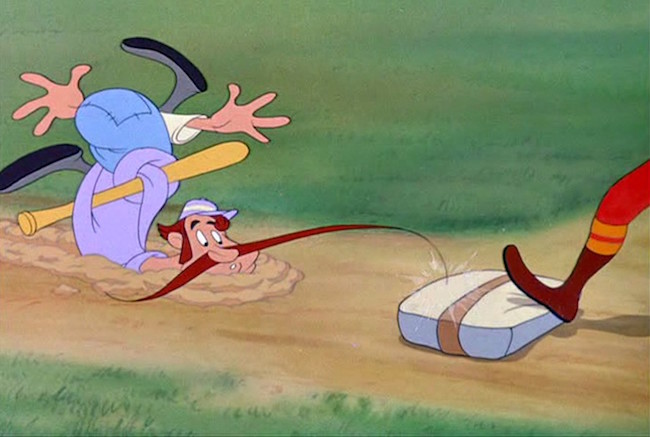
Also creating a bit of an uncomfortable feeling: Johnnie Fedora and Alice Bluebonnet, and not just because it, too, brings back those horrible little cupids. Your tolerance for this one, I fear, will be less based on your feelings about cupids, and more based on your tolerance for watching hats kissing—some of you might be into it, some not.
Anyway, the two hats—a fedora and a bluebonnet—fall in love while standing in a display window, and all seems wonderful and delightful until a woman wanders in and buys the bluebonnet, somewhat inexplicably completely failing to notice that the bluebonnet has, like MOVING EYES and has been making out with a fedora, but let’s move on, separating the two FOREVER AND EVER—or at least until an equally unobservant man strolls in and buys the hat and takes him through the streets, where he gets to see the little sunbonnet again AWWW did I say AWWW I meant creepy because this starts off a segment where the little hat runs off, to be beaten and nearly drowned until someone cuts pieces out of him and he finds himself on a horse but it’s all good because the sunbonnet, also cut up, is right next to him and they start to make out which has got to be kinda awful for the horses. Also for me. It’s all served up with a surprising amount of gunfire and people hitting one another with sticks, plus quite a lot of intrahat violence, for something that’s supposedly just a sweet love story of hats.
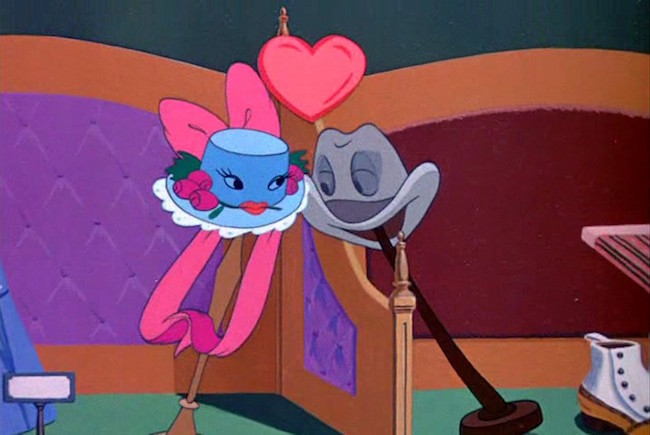
So wait, I hear you saying. Is the entire collection of shorts just largely boring or uncomfortable or mildly or seriously sexist and definitely not worth trying to track down especially given the DVD issues? Well, no, not quite, because in the middle of all this muddle are two good shorts: Peter and the Wolf and The Whale Who Wanted To Sing at the Met.
Peter and the Wolf was another piece considered for Fantasia, and then rejected—according to some sources, because the composition was specifically designed for children, and Walt Disney wanted music written and designed for any age, and according to other sources, because the original piece was designed to be accompanied by narration, something else Walt Disney did not want in Fantasia. What he did want, for this short, at least, was a different, happier ending, the leading example for the argument that Disney bowdlerizes and simplifies its adaptations.
The short starts with matching each character to a different instrument—a conceit that, unlike the ending, is from the original Sergei Prokofiev piece—just before little Peter sets off to hunt the big bad Wolf armed only with a popgun. Little Peter is not very bright, is what I’m saying, even if he thinks he’s a great hunter. He’s joined by various animal friends—Sasha the bird, Sonia the duck, and Ivan the cat. Going after the wolf with a popgun and a duck goes exactly as well as you might suspect. Fortunately, Sasha the bird has the sense to go for help—bringing three hunters to the rescue. By the time the hunters show up, however, Peter and the cat have inexplicably managed to capture the wolf.
Without that scene, I feel cheated—plot hole does not begin to describe the issue of “how did we get from Peter, the cat and the wolf dangling from a tree to this.” But I have to give this short this much credit: the wolf is amazing. Despite barely appearing on screen, he’s one of Disney’s most effective villains—especially since for a good portion of the short, he’s also one of the few Disney villains who seemingly kills someone on screen.
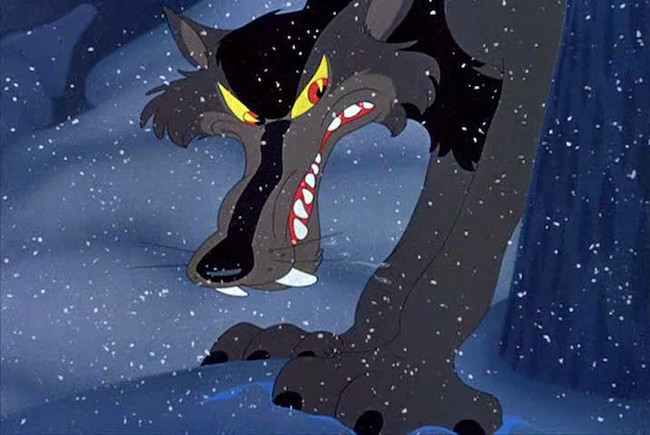
The other good cartoon, The Whale Who Wanted to Sing at the Met, pops up at the end of the piece. It stands out among other Disney works for two reasons: it’s one of the few Disney works to have a bittersweet, almost unhappy ending, and all of its vocal parts—including a singing alto—are voiced by one person, baritone Nelson Eddy, at the time best known for his work in opera and a number of MGM films.
As the short opens, reports are coming in of something extraordinary: a whale that can sing. Opera impresario Tetti Tatti, hearing the reports, is convinced that this is a modern day Jonah story—since whales can’t possibly sing, obviously the only explanation is that the whale has swallowed an opera singer. Maybe two opera singers. Maybe three. Or maybe Tetti Tatti has just watched Pinocchio a few too many times. You decide. Tetti Tatti heads out into the ocean, desperate to find the opera singers.
Sperm whale Willie, meanwhile, is happily crooning away at “Shortnin’ Bread” (a song Nelson Eddy had frequently performed). When informed that a real opera person is looking for him—giving him hope that he might—might—be able to achieve his dream of singing at the Met, he dashes off, impressing sailors, Tetti Tatti and the audience with Figaro, if perhaps not exactly in the way Mozart intended.
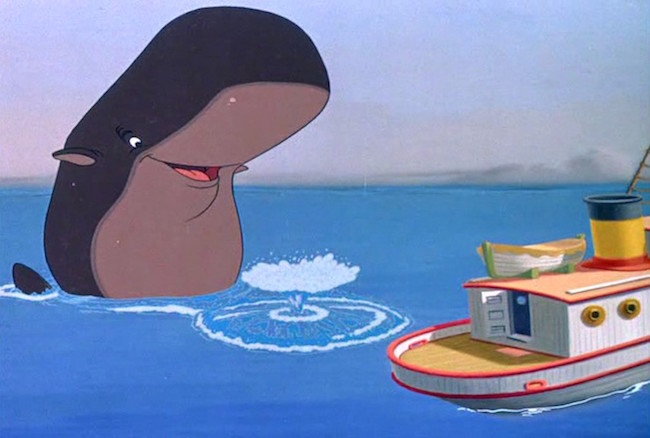
SPOILER: THIS DOES NOT GO WELL, and the narrator’s plea for pity does not help all that much:
“But don’t be too harsh on Tetti Tatti. He just didn’t understand. You see, Willie’s singing was a miracle. And people aren’t used to miracles…”
NOT REALLY AN EXCUSE, NARRATOR.
It’s a rare, impressive example of Disney admitting in their animated works that not everyone will get a happy ending. But more than that, the short also feels, at least, like a not so subtle expression of deep anger, a fury that—as animation artists—they were often not accepted as artists, even after producing beautiful, surreal, marvelous works, trying to comfort themselves with the thought that people aren’t used to miracles.
Oh, and the short also contains a great shot of Willie the Whale looming over the entire audience at the Met, and another shot of him dressed as a clown, fulfilling a need I never realized I had for pictures of sperm whales dressed up as clowns.
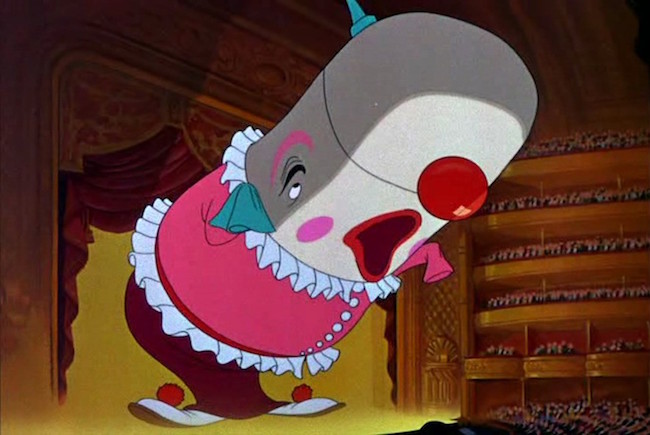
So that was the DVD. Afterwards, I took a look at a poor quality copy of the missing cartoon, The Martins and the Coys, from a copy made back in its Disney channel release. Described as a “rustic ballad,” it’s a remarkably cheerful, happy little song about excessive drinking, a massacre, and square dancing, which ends on a note of spousal abuse, applauded by ghosts (yes, really) set to a remarkably cheerful, bouncy little melody.
Also, midway through the cartoon, its singers pause to catcall and whistle at the pretty—and buxom—heroine.
Fans have claimed that Disney sent this cartoon to its vaults because of the gun violence at its start—a massacre that kills off about 50 or so people, if I’m counting correctly, which I might not be. I question this theory, largely because Disney left a few other episodes of gun violence in the final film, especially in the hat and whale cartoons. I’m also skeptical about the other theory—that Disney removed the cartoon because it’s offensive to pretty much everyone who lives in the Appalachians, although it certainly is that, largely because although Disney has certainly edited out some offensive material, they haven’t edited out all of it, and have rarely seemed particularly concerned about how Appalachian viewers might take this cartoon. The excessive drinking in the short functions as an anti-drinking message, so that’s not it. And although I would love to tell you that Disney removed the cartoon because of the spousal abuse at the end, I don’t think that’s it either.
No, I think in this particular case, Disney seized the opportunity to bury what is just not a very good cartoon. For all of the violence, death, and dancing, it has surprisingly little plot, and that’s before taking into account that a good quarter of the cartoon is just about square dancing. I don’t hate this cartoon—the song is nice and bouncing, and if I’m kinda surprised to see people ending up on a nice heavenly cloud just seconds after they’ve murdered other people, well…it’s a setup for the final joke, and I don’t see any actual angels around them, and they do seem to suffer a bit when they see their last surviving relatives falling in love. And if I question just how a rooster can be taught to squawk “COY” instead of the usual “Cock-a Doodle-Doo,” well, it’s hardly the strangest or most questionable part of this film. But I can also say that if you’ve missed this cartoon, you’re not missing much.
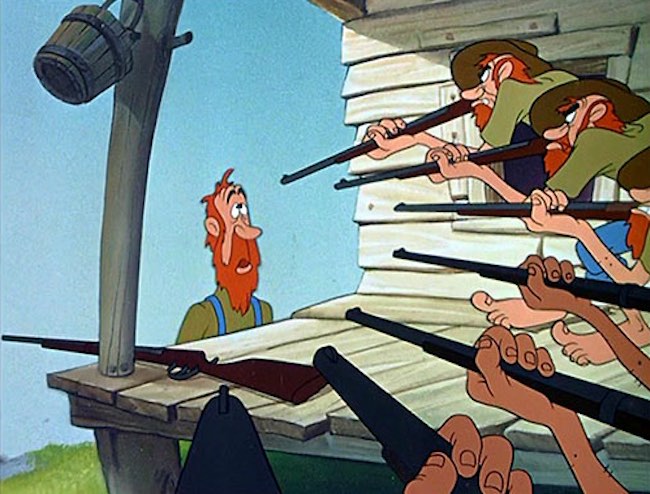
Make Mine Music was yet another box office disappointment for Disney, initially not even earning back its costs. The studio later released most of the cartoons as individual shorts, finding some success with both Peter and the Wolf and The Whale Who Wanted to Sing at the Met, and Disney artists studied the wolf when creating the wolf chase sequences in Beauty and the Beast. But long term, the greatest impact of Make Mine Music seems to have been on Disney restaurants, with a Disneyland restaurant named after Blue Bayou and a Magic Kingdom restaurant named after Casey at the Bat.
In the short term, the poor box office results, and the comparative success of competitor Warner Bros’ shorts, gave a hint, perhaps, that Disney was losing its edge in animated movies –and a sign that, in order to survive, Disney was going to need to branch into other directions. But first, Disney had a few more pieces of concept art that could be turned into another comparatively cheap package film.
Fun and Fancy Free, coming up next.
Mari Ness lives in central Florida.










